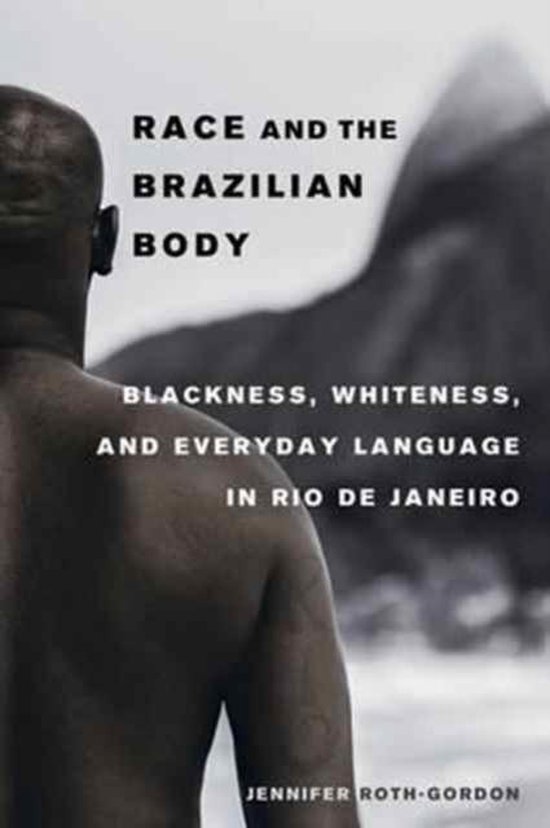
Race and the Brazilian Body
Based on spontaneous conversations of shantytown youth hanging out on the streets of their neighborhoods and interviews from the comfortable living rooms of the middle class, the author shows how racial ideas permeate the daily lives of Rio de Janeiro's residents across race and class lines.
“ Race and the Brazilian Body provides a useful and original contribution to the field of the study of race in urban Brazil. By analyzing the use of language and euphemism, Jennifer Roth-Gordon provides a crucial and heretofore missing component for understanding Brazilian cultural practices associated with race, color, and class. This is an excellent and important study that will be a much-needed addition to the current discussion.”—Jan Hoffman French, author of Legalizing Identities: Becoming Black or Indian in Brazil’s Northeast
“Based on years of field work, this superb book is a complex and nuanced account of how race is produced, experienced, and denied in Rio de Janeiro, interweaving multiple sites of semiotic analysis from the sound of voices to the shape of the city on both small and large scales. The work sets a new standard for the ethnographic study of race and racialization.”—Jane H. Hill, author of The Everyday Language of White Racism
"Poignant and pointed, this fascinating study delves into the everyday practices of racial identification in contemporary Brazil. Roth-Gordon shows how negotiations over strategic acts of self-positioning—amid discourses of “racial cordiality,” class, and security—exacerbate the vulnerabilities of blackness and whiteness. Her sophisticated analysis provides important, fresh insights on Brazil’s long-studied racial contradictions, with clear implications for how ordinary acts can reinforce or challenge broad structures of inequality anywhere."—Kristina Wirtz, author of Performing Afro-Cuba: Image, Voice, Spectacle in the Making of Race and History
Based on spontaneous conversations of shantytown youth hanging out on the streets of their neighborhoods and interviews from the comfortable living rooms of the middle class, Jennifer Roth-Gordon shows how racial ideas permeate the daily lives of Rio de Janeiro's residents across race and class lines. Race and the Brazilian Body weaves together the experiences of these two groups to explore what the author calls Brazil's "comfortable racial contradiction," where embedded structural racism that privileges whiteness exists alongside a deeply held pride in the country's history of racial mixture and lack of overt racial conflict. This linguistic and ethnographic account describes how cariocas (people who live in Rio de Janeiro) "read" the body for racial signs. The amount of whiteness or blackness a body displays is determined not only through observations of phenotypical features-including skin color, hair texture, and facial features-but also through careful attention paid to cultural and linguistic practices, including the use of nonstandard speech commonly described as giria (slang). Vivid scenes from daily interactions illustrate how implicit social and racial imperatives encourage individuals to invest in and display whiteness (by demonstrating a "good appearance"), avoid blackness (a preference challenged by rappers and hip-hop fans), and "be cordial" (by not noticing racial differences). Roth-Gordon suggests that it is through this unspoken racial etiquette that Rio residents determine who belongs on the world famous beaches of Copacabana, Ipanema, and Leblon; who deserves to shop in privatized, carefully guarded, air conditioned shopping malls; and who merits the rights of citizenship.
“ Race and the Brazilian Body provides a useful and original contribution to the field of the study of race in urban Brazil. By analyzing the use of language and euphemism, Jennifer Roth-Gordon provides a crucial and heretofore missing component for understanding Brazilian cultural practices associated with race, color, and class. This is an excellent and important study that will be a much-needed addition to the current discussion.”—Jan Hoffman French, author of Legalizing Identities: Becoming Black or Indian in Brazil’s Northeast
“Based on years of field work, this superb book is a complex and nuanced account of how race is produced, experienced, and denied in Rio de Janeiro, interweaving multiple sites of semiotic analysis from the sound of voices to the shape of the city on both small and large scales. The work sets a new standard for the ethnographic study of race and racialization.”—Jane H. Hill, author of The Everyday Language of White Racism
"Poignant and pointed, this fascinating study delves into the everyday practices of racial identification in contemporary Brazil. Roth-Gordon shows how negotiations over strategic acts of self-positioning—amid discourses of “racial cordiality,” class, and security—exacerbate the vulnerabilities of blackness and whiteness. Her sophisticated analysis provides important, fresh insights on Brazil’s long-studied racial contradictions, with clear implications for how ordinary acts can reinforce or challenge broad structures of inequality anywhere."—Kristina Wirtz, author of Performing Afro-Cuba: Image, Voice, Spectacle in the Making of Race and History
Based on spontaneous conversations of shantytown youth hanging out on the streets of their neighborhoods and interviews from the comfortable living rooms of the middle class, Jennifer Roth-Gordon shows how racial ideas permeate the daily lives of Rio de Janeiro's residents across race and class lines. Race and the Brazilian Body weaves together the experiences of these two groups to explore what the author calls Brazil's "comfortable racial contradiction," where embedded structural racism that privileges whiteness exists alongside a deeply held pride in the country's history of racial mixture and lack of overt racial conflict. This linguistic and ethnographic account describes how cariocas (people who live in Rio de Janeiro) "read" the body for racial signs. The amount of whiteness or blackness a body displays is determined not only through observations of phenotypical features-including skin color, hair texture, and facial features-but also through careful attention paid to cultural and linguistic practices, including the use of nonstandard speech commonly described as giria (slang). Vivid scenes from daily interactions illustrate how implicit social and racial imperatives encourage individuals to invest in and display whiteness (by demonstrating a "good appearance"), avoid blackness (a preference challenged by rappers and hip-hop fans), and "be cordial" (by not noticing racial differences). Roth-Gordon suggests that it is through this unspoken racial etiquette that Rio residents determine who belongs on the world famous beaches of Copacabana, Ipanema, and Leblon; who deserves to shop in privatized, carefully guarded, air conditioned shopping malls; and who merits the rights of citizenship.
| Auteur | | Jennifer Roth-Gordon |
| Taal | | Engels |
| Type | | Paperback |
| Categorie | | Mens & Maatschappij |





